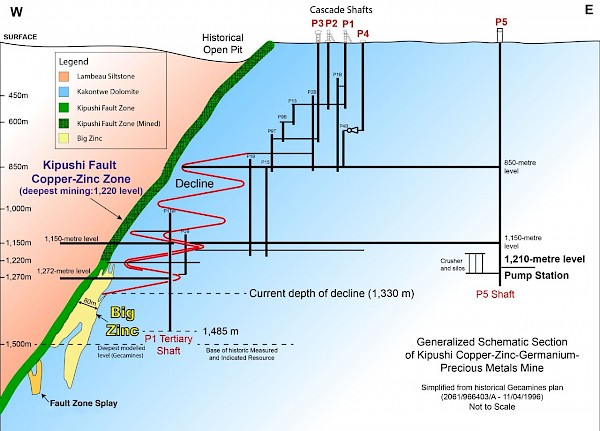Robert Friedland, Executive Chairman of Ivanhoe Mines and Lars-Eric Johansson, Chief Executive Officer, announced today that an independently prepared estimate has resulted in a significant increase in Measured and Indicated Mineral Resources at the company’s high-grade, Kipushi zinc-copper-silver-germanium mine in the DRC. The new Mineral Resource estimate is the first update to be issued for Kipushi since Ivanhoe Mines published its initial, independent NI 43-101 estimate in January 2016.
The new Mineral Resource estimate has increased Kipushi’s Measured and Indicated zinc-rich resources by 16%, from 10.2 Mt to 11.8 Mt, with an increase in zinc grade from 34.89% to 35.34%. In addition, the mine’s Measured and Indicated copper-rich resources have increased by 40% from 1.6 Mt to 2.3 Mt, with a slight increase in the copper grade from 4.01% to 4.03%.
Highlights of this updated estimate, prepared by the MSA Group, of Johannesburg, South Africa, in compliance with CIM definition standards, are:
- Measured and Indicated Mineral Resources, primarily in the Big Zinc Zone, have increased to 11.78 Mt at grades of 35.34% zinc, 0.80% copper, 23 grams per tonne (g/t) silver and 64 g/t germanium, at a 7% zinc cut-off – containing an estimated 9.2 billion pounds of zinc.
- The zinc grade of Kipushi’s Measured and Indicated Mineral Resources is more than twice as high as the world’s next-highest-grade zinc project, independently ranked by Wood Mackenzie, an international industry research and consulting group, based on contained zinc.
- Zinc-rich Inferred Mineral Resources total an additional 1.14 Mt at grades of 33.77% zinc, 1.24% copper, 12 g/t silver and 62 g/t germanium. The Inferred Mineral Resources are contained partly in the Big Zinc Zone and partly in the Southern Zinc Zone.
- Kipushi’s copper-rich Measured and Indicated Mineral Resources contained in the adjacent Fault Zone, Fault Zone Splay and Série Récurrente Zone total an additional 2.29 million tonnes at grades of 4.03% copper, 2.85% zinc, 21 g/t silver and 19 g/t germanium, at a 1.5% copper cut-off – containing 144 million pounds of copper. Copper-rich Inferred Mineral Resources in these zones total an additional 0.44 Mt at grades of 3.89% copper, 10.77% zinc, 19 g/t silver and 55 g/t germanium.
- Ivanhoe’s 2017 drilling program has demonstrated that zinc and copper mineralization of the Kipushi system remain open laterally and at depth.
The new Mineral Resource estimate incorporates Ivanhoe’s second phase of underground drilling at Kipushi that was completed late last year, with a total of 9,706 metres drilled in 58 holes. Eight holes were drilled for metallurgy, 31 holes in the Southern Zinc and Big Zinc, five holes in the Nord Riche and 14 holes in the Série Récurrente. The updated Mineral Resource will be used in the preparation of the Kipushi Definitive Feasibility Study (DFS), which is expected to be finalised later this year or early in 2019.
The DFS will update and refine the findings of the Preliminary Feasibility Study (PFS) issued last December. Similar to the PFS, the DFS will focus on the initial mining of Kipushi’s Big Zinc Zone. The planned return to production would establish Kipushi as the world’s highest-grade, major zinc mine. The Kipushi mine is operated by Kipushi Corporation (KICO), a joint venture between Ivanhoe Mines (68%) and Gécamines (32%), the DRC’s state-owned mining company.
In December 2017, KICO signed a memorandum of understanding (MOU) with Byrnecut Offshore Proprietary Limited (Byrnecut), of Perth, Australia. The MOU relates to the potential engagement of Byrnecut to provide underground mining services at Kipushi, including cost estimation, contractor management, operational readiness and operational services. The planned primary mining method for the Big Zinc Deposit in the PFS is sublevel long-hole, open stoping, with cemented backfill. The crown pillars are expected to be mined once adjacent stopes are backfilled using a pillar-retreat mining method. The Big Zinc Deposit is expected to be accessed via the existing decline and without any significant new development. The main levels are planned to be at 60 m vertical intervals, with sublevels at 30 m intervals.











